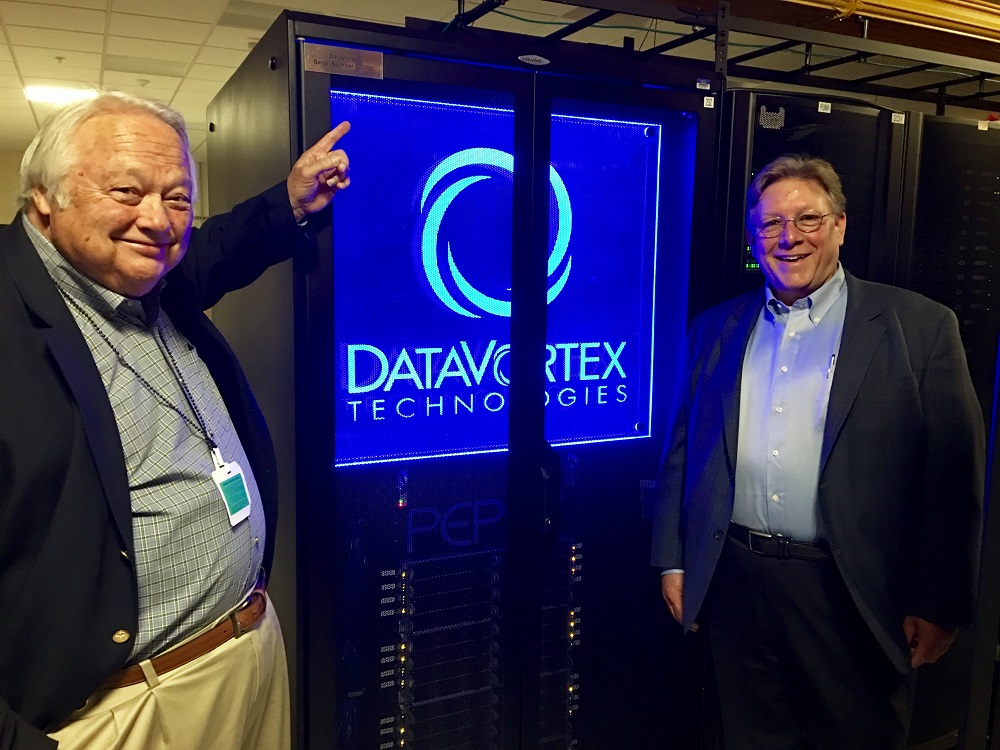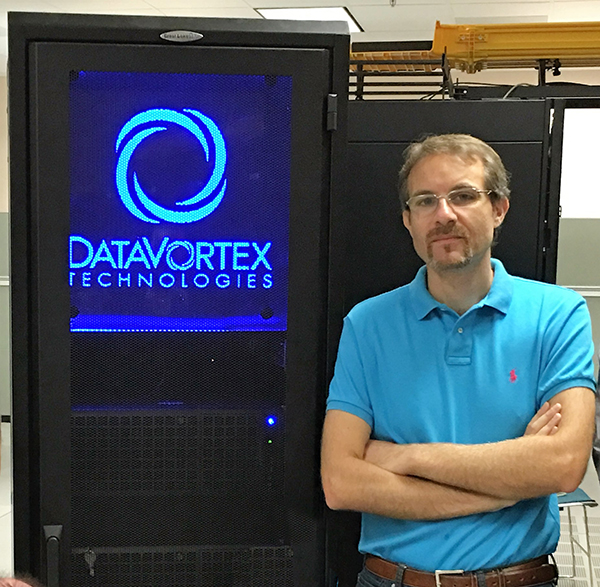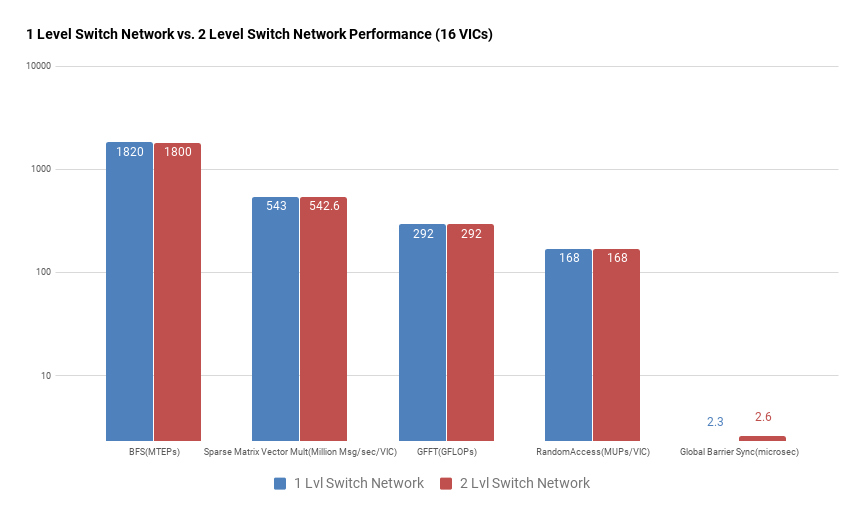Last month (Sept. 11-12), HPC networking company Data Vortex held its inaugural users group at Pacific Northwest National Laboratory (PNNL) bringing together about 30 participants from industry, government and academia to share their experiences with Data Vortex machines and have a larger conversation about transformational computer science and what future computers are going to look like.

The meeting opened with Data Vortex Founder and Chairman Dr. Coke Reed describing the “Spirit of Data Vortex,” the self-routing congestion-free computing network that he invented. Reed’s talk was followed by a series of tutorials and sessions related to programming, software, and architectural decisions for the Data Vortex. A lively panel discussion got everyone thinking about the limits of current computing and the exciting potential of revolutionary approaches. Day two included presentations from the user community on the real science being conducted on Data Vortex computers. Beowulf cluster inventor Thomas Sterling gave the closing keynote, tracing the history of computer science all the way back from antiquity up to current times.
“This is a new technology but it’s mostly from my perspective an opportunity to start rethinking from the ground up and move a little bit from the evolutionary to the revolutionary aspect,” shared user meeting host PNNL research scientist Roberto Gioiosa in an interview with HPCwire. “It’s an opportunity to start doing something different and working on how you design your algorithm, run your programs. The idea that it’s okay to do something revolutionary is an important driver and it makes people start thinking differently.”

“You had that technical exchange that you’d typically see in a user group,” added John Johnson, PNNL’s deputy director for the computing division. “But since we’re looking at a transformational technology, it provided the opportunity for folks to step back and look at computing at a broader level. There was a lot of discussion about how we’re reaching the end of Moore’s law and what’s beyond Moore’s computing – the kind of technologies we are trying to focus on, the transformational computer science. The discussion actually was in some sense, do we need to rethink the entire computing paradigm? When you have new technologies that do things in a very very different way and are very successful in doing that, does that give you the opportunity to start rethinking not just the network, but rethinking the processor, rethinking the memory, rethinking input and output and also rethinking how those are integrated as well?”
The heart of the Data Vortex supercomputer is the Data Vortex interconnection network, designed for both traditional HPC and emerging irregular and data analytics workloads. Consisting of a congestion-free, high-radix network switch and a Vortex Interconnection Controller (VIC) installed on commodity compute nodes, the Data Vortex network enables the transfer of fine-grained network packets at a high injection rate.
The approach stands in contrast to existing crossbar-based networks. Reed explained, “The crossbar switch is set with software and as the switches grow in size and clock-rate, that’s what forces packets to be so long. We have a self-routing network. There is no software management system of the network and that’s how we’re able to have packets with 64-bit headers and 64-bit payloads. Our next-gen machine will have different networks to carry different sized packets. It’s kind of complicated really but it’s really beautiful. We believe we will be a very attractive network choice for exascale.”
Data Vortex is targeting all problems that require either massive data movement, short packet movement or non-deterministic data movement — examples include sparse linear algebra, big data analytics, branching algorithms and fast fourier transforms.
The inspiration for the Data Vortex Network came to Dr. Reed in 1976. That was the year that he and Polish mathematician Dr. Krystyna Kuperberg solved Problem 110 posed by Dr. Stanislaw Ulam in the Scottish Book. The idea of Data Vortex as a data carrying, dynamical system was born and now there are more than 30 patents on the technology.
Data Vortex debuted its demonstration system, KARMA, at SC13 in Denver. A year later, the Data Vortex team publicly launched DV206 during the Supercomputing 2014 conference in New Orleans. Not long after, PNNL purchased its first Data Vortex system and named it PEPSY in honor of Coke Reed and as a nod to Python scientific libraries. In 2016, CENATE — PNNL’s proving ground for measuring, analyzing and testing new architectures — took delivery of another Data Vortex machine, which they named JOLT. In August 2017, CENATE received its second machine (PNNL’s third), MOUNTAIN DAO.

MOUNTAIN DAO is the first multi-level Data Vortex system. Up until this generation, the Data Vortex systems were all one-level machines, capable of scaling up to 64 nodes. Two-level systems extend the potential node count to 2,048. The company is also planning for three-level systems that will be scalable up to 65,653 nodes, and will push them closer to their exascale goals.

PNNL scientists Gioiosa and Johnson are eager to be exploring the capabilities of their newest Data Vortex system.
“If you think about traditional supercomputers, the application has specific characteristics and parameters that have evolved to match those characteristics. Scientific simulation workloads tend to be fairly regular; they send fairly large messages so the networks we’ve been using so far are very good at doing that, but we are facing a new set of workloads coming up — big data, data analytics, machine learning, machine intelligence — these applications do not look very much like the traditional scientific computing so it’s not surprising that the hardware we been using so far is not performing very well,” said Giosiosa.
“Data Vortex provides an opportunity to run both sets of workloads, both traditional scientific application and matching data analytics application in an efficient way so we were very interested to see how that was actually working in practice,” Gioiosa continued. “So as we received the first and second system, we started porting workloads, porting applications. We have done a lot of different implementations of the same algorithm to see what is the best way to implement things in these systems and we learned while doing this and making mistakes and talking to the vendor. The more we understood about the system the more we changed our programs and they were more efficient. We implement these algorithms in ways that we couldn’t do on traditional supercomputers.”
Johnson explained that having multiple systems lets them focus on multiple aspects of computer science. “On the one hand you want to take a system and understand how to write algorithms for that system that take advantage of the existing hardware and existing structure of the system but the other type of research that we like to do is we liked to get in there and sort of rewire it and do different things, and put in the sensors and probes and all different things, which can help you bring different technologies together but would get in the way of porting algorithms directly to the existing architecture so having different machines that have different purposes. It goes back to one of the philosophies we have, looking at the computer as a very specialized scientific instrument and as such we want it to be able to perform optimally on the greatest scientific challenges in energy, environment and national security but we also want to make sure that we are helping to design and construct and tune that system so that it can do that.”
The PNNL researchers emphasized that even though these are exploratory systems they are already running production codes.
“We can run very large applications,” said Gioiosa. “These applications are on the order of hundreds of thousands of lines of code. These are production applications, not test apps that we are just running to extract the FLOPS.”
At the forum, researchers shared how they were using Data Vortex for cutting-edge applications, quantum computer simulation and density function theory, a core component in computational chemistry. “These are big science codes, the kind you would expect to see running on leadership-class systems and we heard from users who ported either the full application or parts of the application to Data Vortex,” said Johnson.
“This system is usable,” said Gioiosa. “You can run your application, you can do real science. We saw a simulation of quantum computers and people in the audience who are actually using a quantum computer said this is great because in quantum computing we cannot see the inside of the computer, we only see outside. It’s advancing understanding of how quantum algorithms work and how quantum machines are progressing and what we need to do to make them mainstream. I call it science, but this means production for us; we don’t produce carts but we produce tests and problems and come up with solutions and increase discovery and knowledge so that is our production.”
Having held a successful first user forum, the organizers are looking ahead to future gatherings. “There are events that naturally bring us together, like Supercomputing and other big conferences, but we are keen to have this forum once every six months or every year depending on how fast we progress,” said Gioiosa. “We expect it will grow as more people who attend will go back to their institution and say, oh this was great, next time you should come too.”
What’s Next for Data Vortex
The next major step on the Data Vortex roadmap is to move away from the commodity server approach they have employed in all their machines so far to something more “custom.”
“What we had in this generation is a method of connecting commodity processors,” said Dr. Reed. “We did Intel processors connected over an x86 (PCIe) bus. Everything is fine grained in this computer except the Intel processor and the x86 bus and so the next generation we’re taking the PCIe bus out of the critical path. Our exploratory units [with commodity components] have done well but now we’re going full custom. It’s pretty exciting. We’re using exotic memories and other things.”
Data Vortex expects to come out with an interim approach using FPGA-based compute nodes by this time next year. Xilinx technology is being given serious consideration, but specific details of the implementation are still under wraps. (We expect more will be revealed at SC17.) Current generation Data Vortex switches and VICs are built with Altera Stratix V FPGAs and future network chip sets will be built with Altera Stratix 10 FPGAs.
Data Vortex has up to this point primarily focused on big science and Department of Defense style problems, but now they are looking at expanding the user space to explore anywhere there’s a communication bottleneck. Hyperscale and embedded systems hold potential as new market vistas.
In addition to building its own machines, Data Vortex is inviting other people to use its interconnect in their computers or devices. In fact, the company’s primary business model is not to become a deliverer of systems. “We’ve got the core communication piece so we’re in a position now where we’re looking at compatible technologies and larger entities to incorporate this differentiating piece to their current but more importantly next-generation designs,” Data Vortex President Carolyn Coke Reed Devany explained. “What we’re all about is fine-grained data movement and that doesn’t necessarily have to be in a big system, that can be fine-grained data movement in lots of places.”





























































